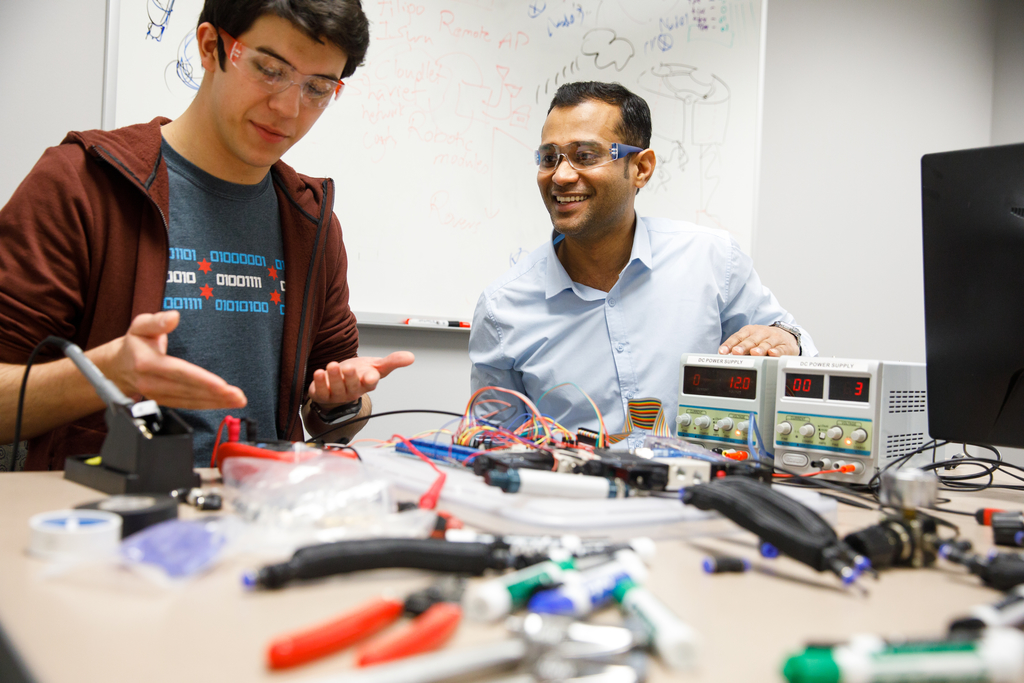 Gregory Mendez Weeks (left), a 2019 College of Computing and Digital Media graduate, works with Isuru Godage, an assistant professor in the School of Computing, in 2018. Godage was recently awarded a Faculty Early CAREER Development grant to develop the next generation of soft robot design. (Photo courtesy of the College of Computing and Digital Media)
Gregory Mendez Weeks (left), a 2019 College of Computing and Digital Media graduate, works with Isuru Godage, an assistant professor in the School of Computing, in 2018. Godage was recently awarded a Faculty Early CAREER Development grant to develop the next generation of soft robot design. (Photo courtesy of the College of Computing and Digital Media)
The tragic collapse of the Champlain Towers South condominium in Surfside, Fla., and the difficult recovery efforts that ensued, left many people wondering whether there could be a quicker and safer way to search for survivors and recover victims.
Researcher Isuru Godage, assistant professor in the School of Computing, hopes he has a solution. Thanks to support from the National Science Foundation, Godage is working to develop the next generation of soft robot design that would transform the field of robotics.
The goal is to provide first responders with a secret weapon — dozens of transformable, soft robots that can be deployed in any opening found around the perimeter of a collapsed building. The robots, which could change into snake or legged robot forms, are capable of adapting to what's in front of them — whether that be a staircase, small sewer line openings or a pool of water. The result is a safe way to alert first responders to survivors the robots find along the way, thus providing a blueprint on where rescue efforts should begin.
Godage is a recent recipient of a Faculty Early CAREER Development grant, NSF's most prestigious award in support of early-career faculty who have the potential to serve as academic role models in research and education and to lead advances in the mission of their department or organization. The $529,999, five-year research grant will support Godage as he looks to significantly advance the theory and practice of reconfigurable heterogeneous soft robots in the interconnected areas of design, fabrication, morphological optimization and intelligent control.
A new approach to robotics
Current robots usually fall into one of five categories: pre-programmed robots like those found in assembly lines; humanoid robots that look like or mimic human behavior; autonomous robots like Roombas; augmenting robots like prosthetic limbs or exoskeletons; or teleoperated robots like drones.
Most of these robots are rigid and have a fixed configuration that cannot be altered once assembled. Of the robots that can be reconfigured for a variety of circumstances, the majority have been built with rigid materials and pneumatics, which can make them impractical for fieldwork. Pneumatic robots need to be tethered to a compressor, for instance, and that cord can get tangled and damaged easily, Godage says.
Godage's plan to address these concerns is twofold. Instead of using pneumatics, he aims to run his robots on electromechanical design, which would allow them to be portable and tetherless. In the beginning, humans would command the robots, but Godage's vision would be to install additional sensors to allow the robot to decide what to do autonomously.
For the design, Godage is finding inspiration in the tail of nature's spider monkey. A spider monkey tail is made of an endo skeleton, surrounded by muscles that help it bend at any point and perform complex tasks like grasping tree limbs while swinging from trees.
"We would like for this robot to have a rigid skeleton on the inside, but the outside is made of soft materials such as silicone and rubber that can bend without buckling or crushing the internal components," he says.
Godage envisions his robots serving many purposes, including planetary exploration or intelligence gathering.
"The Mars Rover vehicles are groundbreaking, but sometimes you need to search for life in really challenging areas, maybe in some liquid pools, caves or crevices. These robots would be perfect for that," he says. "Or they could also be used for reconnaissance. You could roll the robot into a ball and drop it to the ground to gather intelligence — without sending humans into potentially dangerous situations."
Educational component
NSF CAREER grants have a larger educational component than typical NSF grants. Godage hopes to use the design, fabrication and testing of these robot modules to build curriculum for design, electronics and advanced research classes at DePaul.
He also plans to use the funding to host Chicago Public Schools students every year for workshops in his robotics and medical engineering lab, where he would conduct three-hour introductory sessions on robotics and electronics. Some of the funding would go toward scholarships for CPS students to attend the workshops for free.